KORG SDD-3000 PEDAL
Why do we still love the equipment of the '80s?
Was there a certain incident that was the impetus for the resurrection of the SDD-3000?
KORG development team (subsequently "K"): We were contacted to repair an original SDD-3000 for an engineer who specialized in repairs for Dallas Schoo (the guitar technician for U2's The Edge). We did some investigation, but there were no parts available to do the repair. For that reason, we initially declined the request. However, they requested again, asking "isn't there something that can be done?" That was towards the end of 2008. Until then, there had been no talk within KORG about bringing back the SDD-3000.
In other words, the original device really was that important to The Edge.
K: He continues to use it even though it's decades old, and has stockpiled numerous units as backups. Apparently, he also has a collection of broken original units that he uses for parts. After learning this, we asked ourselves “Why would he go to such lengths to continue using this unit”? Well, even if we couldn't fix it, maybe we could make a one-off replacement unit that we could provide him. That's how the project got started.
Regarding the original SDD-3000, one often hears that the slight tonal change produced by the preamp (attenuator section) is important.
K: In our case as well, we started by analyzing the reason that the original device has been used for so long. We had certainly heard that the attenuator section is important. However, we needed to first verify whether this really was the case. Otherwise, we wouldn't be able to create something that would satisfy the actual needs of the musician on stage. So, we started by creating a prototype that was focused on the entrance and exit of the sound and had Dallas Schoo try it out and give us his opinion.
What was the response from Dallas Schoo?
K: He told us that the preamp section was close to the original, but the delay was completely different. It is said that the reason the sound of the original device was so highly regarded was due to the characteristics of the preamp section, but that's not the only factor. The sound of the original device was also due to factors such as losses in the internal AD/DA converter, and to the modulation structure. At that point, we re-thought our direction regarding the input and output, and decided we would make it as close as possible to the original. Also, we decided to choose the same part numbers and characteristics for the preamp, and use the same circuit. But for the delay section, we decided to use DSP modeling that would provide better precision and also let us add new functionality.
In the end, how much was Dallas Schoo involved in development?
K: He made various requests, and we continued making improvements based on those requests. I think we made about six prototypes. Normally, there's not this much back-and-forth.
Unique specifications of the original unit, and the difficulty of reproducing them today
Why did the input section of the original unit have an attenuator in the first place?
K: With the original unit, we assumed that a variety of devices would be connected to it. The -10 dB and -4 dB settings are used when connecting line-level equipment such as a PA console. When connecting a guitar, it's common to use the -30 dB setting. However, many guitarists actually use it with the -10 dB setting. In particular, if you're connecting a guitar directly, the impedance of the guitar pickup will interact with the impedance of the receiving device (the SDD-3000), so that the setting of the input attenuator will significantly change the sound.
Do you know how The Edge takes advantage of those characteristics?
K: I don't know exactly how The Edge uses it. However, when developing the SDD-3000 Pedal, we initially planned to place the attenuator switch on the rear panel. Our thinking was that once you've decided on the setting, you wouldn't change it very often. However, Dallas Schoo requested that we move it to the front panel. Judging from that, it could be that The Edge changes the setting depending on the guitar. In fact, we were actually asked if we could make that area programmable as well. However, this would have required a major change from the original circuit, which would change the sound. For that reason, we were unable to grant that request.
There's also an attenuator on the output side. How should this be balanced with the input side?
K: When using the unit as a conventional delay, an input setting of -30 dB would typically be used with an output setting of -20 dB or -10 dB. The input level should be set as high as possible without causing clipping. You would use INPUT LEVEL as a fine tuner to make small adjustments. However, it appears that most people using the original unit are not using it in this way. For example if you set output to +4 dB, the sound will distort at the amp head, although this does depend on the amp you're using.
So, contrary to the expectations of the developers, the irregular settings turned out to be the regular way of using the unit?
K: Setting the attenuator to make the signal distort was certainly not what the developers expected, but since the unit is actually being used in this way, we had to give the revival model the same specifications. That means the power supply voltage also had to be close. However, using a dedicated AC adapter to supply the power is inconvenient, and does not fit with today's equipment. So, while keeping the 9V adapter specification, we used a method of boosting the voltage internally. We essentially created the analog circuitry of the SDD-3000 for that purpose. We did things that would have invited criticism for financial irresponsibility if we had used such methods on a different device (laughs). Still, we held our ground for the sake of remaining faithful to the original unit.
Is the power supply really that important?
K: The circuit is on the Internet, and there are some people who have created a pedal that copies just the preamp section of the original. I also bought one and tried it, but even though the circuit is an exact copy, the sound is somehow different. I think it's because the power supply section didn't receive much thought. That's another reason that we wanted the power supply voltage of the SDD-3000 Pedal to be the same as the original. Even when stepping up the voltage, we stepped up both legs, not just the positive side. In other words, we did the best we could with analog circuitry, and used DSP to handle what analog couldn't manage.
For the delay section, I understand that reconstruction was impossible because of the unavailability of parts. What was the actual item that was unavailable?
K: The original unit was created in an age when players had not yet become common. At the time, there were no affordable 16-bit AD/DA converters. For this reason, the original unit used special converters with an unusual 13-bit design; 12-bit + 1-bit.
Would that mean that the resolution was fairly low by today's standards?
K: A typical digital effect unit today uses 24-bit AD/DA converters, so 13-bit conversion has a comparatively low resolution and a rougher sound. There were differences of opinion as to how we should handle the distortion in the delay sound that's caused by this low resolution. But if we make it a high resolution, the tonal character would be different from the original. That's why we used DSP to simulate that as well, and deliberately degraded it.
Preserve the original unit's response, yet also develop it using modern technology
I understand that for the SDD-3000 Pedal, some functionality was added or rearranged to the original device.
K: The biggest thing was the modulation section. The modulation functionality of the original device, as well as of other delay units made at the time, was designed in a way that once you specified the waveform and depth to create the sound, changing the delay time would destroy the balance. There were cases in which this would produce a good sound, but from the viewpoint of the user it was hard to adjust. We tried using DSP to simulate this behavior as well, but in spite of requiring a large amount of processing power, it wasn't easy to use, so we decided to rearrange it. We designed the new unit so that you could morph (seamlessly modify) the waveform, preserving the nuances of the original unit's sound yet making it easy to adjust.
Is the filter section analog?
K: It might seem to be analog since the design uses a push switch, but this too is processed using DSP. The response is exactly the same as the original unit. This filter cuts the feedback sound in the regions above or below the specified value. In the case of The Edge, he's probably using settings that make the feedback sound stand out, probably by cutting 500 Hz or 250 Hz.
Regarding the delay, I see that the new unit provides other delays in addition to SDD-3000 mode. What are their features?
K: In addition to the 13-bit delay of the original unit, I think that the modulation function played a major role in determining the unit's unique character. Thinking that it would be interesting to combine that function with a modern-quality delay, we provided a MODERN mode. Conversely, the REVERSE mode came from asking what would happen if we played the sound of the SDD-300 backward. When the original unit was developed, reverse-playback was a function that would have been impossible to implement. In other words, the developers asked whether we might get something new if we combined the original unit's characteristics with today's technology.
Did you consider doing a perfect reproduction of the original device without adding any such new functionality?
K: Although this is not limited to the SDD-3000 Pedal, KORG's policy when reviving a product is to preserve what should be preserved and change what should be changed. That means that features that could not be provided by the technology of the time can be provided appropriately for today's needs. Examples of this would be details such as eliminating the waveform skew and getting rid of noise.
In other words, you're using today's technology to deliver things that the engineers at the time were unable to provide in spite of all their best efforts.
K: In that sense, rather than a "revival" it might be better to call this a "replacement." If it was a matter of completely reviving the original, we would have needed to create it as a rack-mount unit. Also, the original unit was not made specifically for guitarists, but the SDD-3000 Pedal was developed mainly for guitarists. If guitarists are going to use it, placing it underfoot is far more convenient, which is why we made it a floor-type unit. Additionally, the SDD-3000 Pedal started development as a professional-use device, which is why it also provides MIDI functionality.
The result has been that the SDD-3000 Pedal carries on the true essence of the original device, while also being a multi-function delay that can also meet the needs of today. What would you would most like to emphasize to the user?
K: The first thing is to experience the sound quality. It's completely different than compact delay units powered by a 9V battery, which is something that really should be emphasized. For components such as the AD/DA convertors, we've used parts of equivalent quality to those used in studio equipment. In other words, starting with the hardware structure, this is different than a typical stomp box-type delay. And regarding the sound, it's important to remember that we arrived at this result through listening tests with Dallas Schoo, who has probably spent more time with the original unit than anyone else in the world. This unit is constructed completely differently than a typical stomp box. It's true that this is our business, but I'd like to say that the SDD-3000 Pedal took shape from the thoughts that we and the users had about the original unit.
-
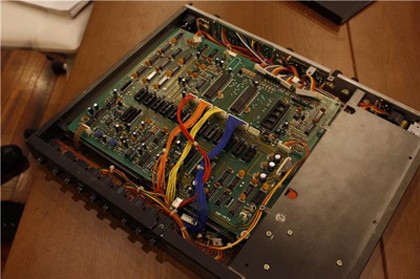
An original SDD-3000 used for analysis. The digital circuits are located in this area.
-
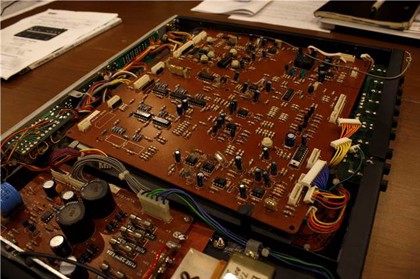
This is the circuit board for the analog section. It's equipped with JRC-made op-amps and other components familiar to effect unit aficionados.
-
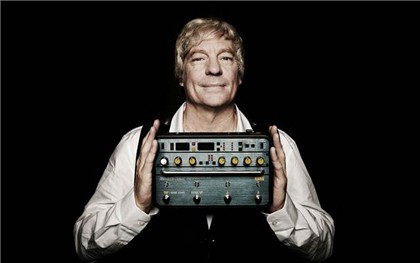
The Edge's guitar tech Dallas Schoo
-
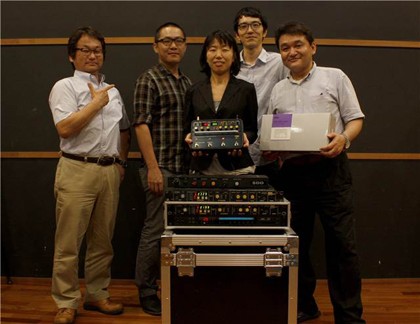
The people of the development team who responded to the interview. From the left, they are Tadashi Sano, Yuji Kawamura, Chiharu Hirose, Akihito Ogino, and Naohiro Oho. Of these, Mr. Oho is a particularly rabid fan of U2.
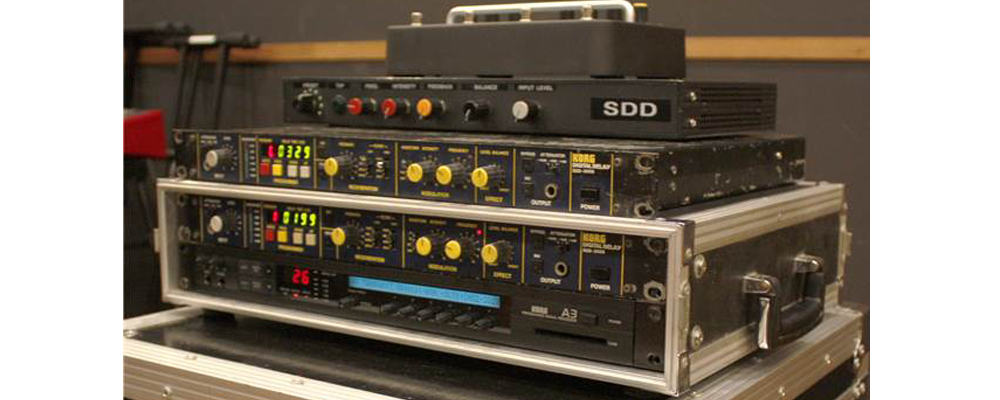
Two completely functional SDD-3000 units used for analysis, a completed SDD-3000 Pedal, and one of the prototypes that came between them.
The revival of the SDD-3000 has been long awaited. Although it has come back as a pedal-type unit, it's not too much to say that the classic sound of the past has been reproduced perfectly. That special sound that took the world by storm in the 80s and 90s is once again obtainable with all its uniqueness, such as headroom that lets the tone sound like it's passing through a tube amp, and the filter that's applied to the delay repeats.
The SDD-3000 was purchased by numerous guitarists as soon as it went on sale. Daniel Lanois, Johnny Marr are well-known users, but the fact that U2's The Edge, also known as "the magician of delay," still uses this unit as his main delay is the strongest testimonial to the amazing character of the SDD-3000. The Edge has three SDD-3000 units in his rack, each with different input gain (attenuator settings), apparently for use with specific guitars. He also uses the SDD-3000's output attenuator to attain his sound by boosting the signal to his amp. One of the three units is set to avoid producing distortion, and is sent to his main AC30 amp. The other two units are gain-boosted and sent to other amps (AC30, and others). In other words, it's fair to say that his signature tone is created using a combination of the SDD-3000 with his amps. It seems that the boost produced by the SDD-3000's preamp section cannot be replaced by another booster. The tone produced by the SDD-3000 head amp is simply that attractive. To reproduce The Edge's sound with the SDD-3000 Pedal, set the input attenuator to -30 dB and the INPUT LEVEL to about 7 (lower this if the sound distorts). Set the DELAY TIME so that you get a dotted 8th (pressing the R TIME and VALUE switches simultaneously takes you to the edit screen). It does without saying that the delay mode is set to SDD-3000. Set FEEDBACK to about 5, leave INV turned off, select 500 Hz and 2 kHz for the filter (but adjust this appropriately for the amp that's connected), set WAVEFORM to the "~" position, set INTENSITY to about 1 or 2, and raise FREQUENCY to the range of 6--7. Without using this modulation to create a sense of motion, you won't get a fully three-dimensional sound, so be sure to make the fine adjustments you'll need for each venue. Set BALANCE so that the direct sound and effect sound are about half-and-half. Set the output attenuator to -20 dB, and of course place the SDD-3000 pedal before your amp. With these settings, you should be able to create the right general impression.
Leaving aside any further talk about The Edge, the tonal character of the SDD-3000 Pedal is, in a word, simply wonderful. It has a thick sound, clear highs, and buoyant mid-range. As far as the delay sound, the key is to skillfully use not just the filter but also the modulation section to obtain the desired overall character. The rule is to keep the INTENSITY low and the FREQUENCY fairly high. Of course, it's up to you if you want to use dramatic modulation, but take care that the sound of the effect processor doesn't overwhelm things. Keeping the effect to the degree of coloration is the key to creating cool delay sound. Personally, I thought that the newly added REVERSE and MODERN modes were especially nice. Used with the filter, you can create analog-like delays that have a real sense of quality.
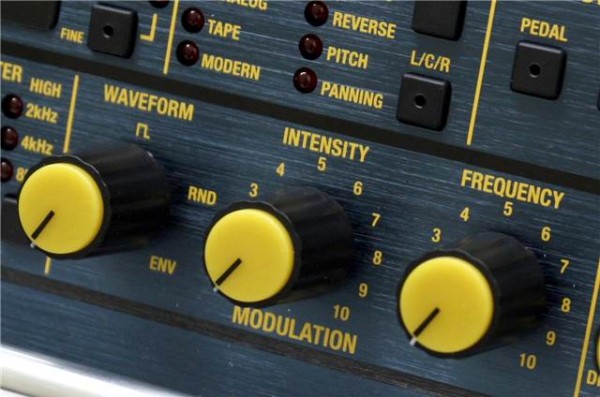
Modulation
This function creates cyclic change. The original device had a selector that let you choose the waveform, but the revival model also lets you specify an intermediate waveform.
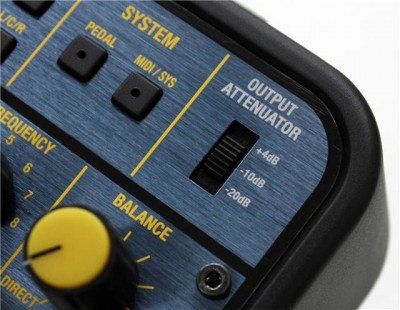
Output Attenuator
The output section also faithfully reproduces the original. Bypass typically retains the preamp function, but true-bypass is also possible.

SDD-3000 Digital Delay
A dedicated delay device that went on sale in 1982 as a rack-mount unit (production ended in 1985). In an age where digital delays were ultra-high-end devices for professional use, the SDD-3000 was released at a price (185,000 yen) that was generally affordable to ordinary people, and was a factor in the subsequent popularity of rack-mountable effect units.

Rear View
The input is monaural, and only the output is stereo. Although it did not support MIDI, you could connect an external controller and use your foot to control functions such as program selection.


